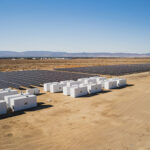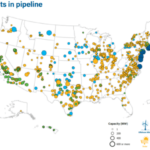Total U.S. energy storage installs rise in Q2, but residential dips because of supply shortages
According to Wood Mackenzie, a Verisk business, and the U.S. Energy Storage Association’s (ESA) latest “U.S. Energy Storage Monitor” report, 345 MW of new energy storage systems were brought online in the second quarter of 2021.
This is an increase of 162% over the same quarter in 2020, making Q2 2021 the second-largest quarter on record by megawatt for U.S. energy storage additions. Market momentum continues to build, as an unprecedented volume of storage will come online in in the second half of the year, with Wood Mackenzie expecting that storage projects representing over $5 billion of investment will come online in 2021 alone.
Despite positive market momentum in the United States, the residential battery market dipped slightly, the first drop for the segment in nine quarters (since Q4 2018). Equipment constraints, including an ongoing Tesla Powerwall shortage, is hampering the segment’s growth despite the proliferation of new residential storage players.
The non-residential segment, which consists of onsite storage and community-scale storage, saw quarter-on-quarter deployments rise by 31%, driven by the growth of the community storage market in Massachusetts.
The front-of-the-meter (FTM) market deployed 218 MW/729 MWh in Q2 2021, with California, Texas and Arizona leading the segment. California continued to lead the FTM segment in Q2, with Arevon/Capital Dynamics’s 100-MW/400-MWh Saticoy Energy Storage peaker plant replacement in Ventura County contributing most of the megawatts for the quarter. Solar + storage projects in Texas and Arizona also bolstered Q2 FTM capacity.
“The United States remains on course for a record-setting year, further demonstrating battery storage’s growing acceptance within the power market and underlining its importance to the energy transition,” said Vanessa Witte, senior energy storage analyst with Wood Mackenzie.
“While the market for energy storage in the U.S. has seen tremendous growth this year, public policy has yet to support the pace of deployment needed to meet decarbonization and resilience goals,” said Jason Burwen, U.S. Energy Storage Association Interim CEO. “An investment tax credit, which catapulted industries like solar and wind, can do the same for the energy storage industry — with the added benefit of steering more supply chain investment decisions onshore.”
Policy support continued to build in the second quarter, with several new state incentives introduced for residential and non-residential storage. The industry also still awaits the outcome of budget reconciliation, expected this winter, which could include a solar investment tac credit (ITC) extension and/or standalone storage ITC. A positive outcome would upgrade the energy forecast across all segments.
News item from ESA
<!–
–>
Original Source: https://www.solarpowerworldonline.com/2021/09/total-u-s-energy-storage-installs-rise-in-q2-but-residential-dips-because-of-supply-shortages/













